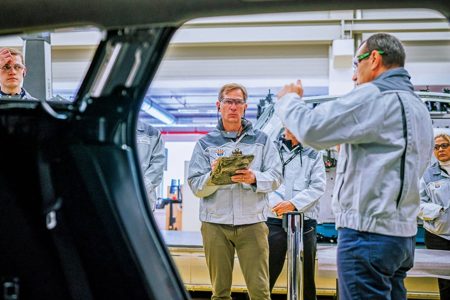Some big, strategic decisions, however, must be made at the top of the house, like where to make vehicles and who supplies the batteries. The big ones that stand out to me right now are around timing and pricing.
The company is set to officially begin production of the Ocean on Thursday, Nov. 17, as has been planned for more than a year. It should win the company some credibility in contrast to Elon Musk’s track record at Tesla, where he repeatedly announced plans that didn’t get done when he said they would — or sometimes at all — though it mostly has worked out fabulously for him.
Still, this start of production doesn’t mean that the first of the Ocean’s 60,000-plus reservation holders are going to get their cars in 2022: Approval for global sales is still weeks or months away.
I found it curious that the car will go into production with many key features to come later. Cruise control, for instance, is a pretty basic offering that won’t be ready at launch. Other, higher-end capabilities also won’t be immediately released, such as its Power Bank package for vehicle-to-home and vehicle-to-vehicle charging, which should roll out over 2023 and ’24, according to materials provided to journalists here.
One factor, of course, is the need for such systems to work quite perfectly so as to not endanger drivers, passengers or neighbors. More strategically, Henrik Fisker explained, is prioritizing the exceptional features that would compel a purchase. (He isn’t a big fan of cruise control himself.)
The consumers of the world, he argues, are not clamoring for another car that does what all cars do. His aim is to provide features that can’t be found anywhere else: best-in-class range, the rotating 17.1-inch screen, the solar roof that helps charge the battery — as well as the doggie windows in back and taco trays for front-seat passengers.
Another tough decision: pricing.
It’s no secret that inflation is bedeviling not only the U.S. economy but the entire world — and perhaps nowhere more than in Europe, where war has made energy scarce and dollar-euro parity has made imports more expensive.
And the EV boom has sent the prices of critical minerals for batteries soaring — with years to come before new mining, processing and manufacturing can be brought up to speed.
Tesla raised prices. Ford raised EV prices. Rivian raised prices — then quickly reversed course.
Henrik Fisker said he promised customers to hold the line on prices at least through the first 40,000 vehicles produced — a threshold the company expects to surpass in the second half of next year. Geeta Fisker stressed that the company has good cost controls and didn’t plan for any models to be loss leaders — underpriced products that lose money in order to attract customer interest.
Including money raised in the third quarter that essentially covered the cash used in operations and investing, the leaders are confident they can make it through the first launch, find their place in the market, and earn enough to get through the introduction of its planned second model, the Pear, and beyond.

